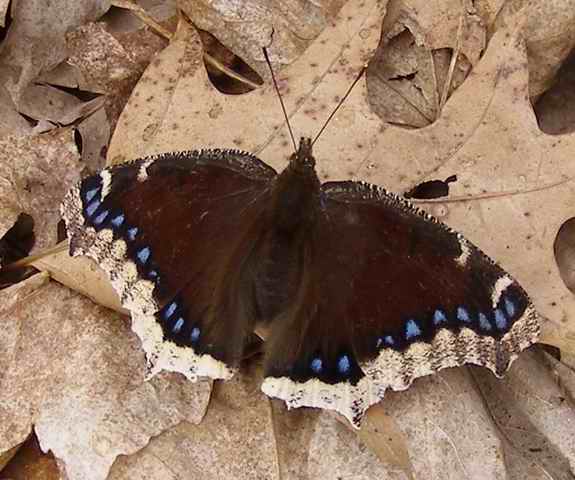|
Return to Hiker's Notebook Home Page
Common Name: Mourning Cloak, Morning Cloak, Mourningcloak, Harbinger of Spring, Camberwell beauty - The name Mourning Cloak is due to the appearance of the dorsal surface of the wings, said to resemble the traditional cloak worn by those in mourning, which was sometimes draped over the casket of the deceased.
Scientific Name: Nymphalis antiope - The generic name is from the Greek nymphe, which was the name given in both Roman and Greek mythology to any of a number of minor nature goddesses who were young and beautiful, living in rivers, mountains, or trees. The reference here is to the goddess-like sylvan nature of the Mourning Cloak. Antiope was a noted beauty of Greek mythology who was seduced by Zeus in the form of a Satyr. She bore two sons, Amphion and Zethos, the founders of the Greek city of Thebes. The species name antiope creates a tautonym, as both of the scientific names of the Mourning Cloak refer to its embodiment of mythological beauty.
The Mourning Cloak is one of the first butterflies to appear as the days start to lengthen at the end of the winter, usually several weeks before spring, depending on the latitude. The reason for this seemingly anomalous behavior is that the Mourning Cloak overwinters as an adult, contrary to most other butterflies and moths that overwinter as eggs, larvae or pupae. The common name "harbinger of spring" is a reflection of its symbolism of the vernal renaissance of the woodland flora and fauna. The Mourning Cloak is a very successful species with a worldwide distribution in the northern hemisphere from the subtropics to the Arctic Circle. It is somewhat rare in Great Britain; it was first discovered near Camberwell in the 18th Century and given the name Camberwell beauty. In addition to the evolutionary adaptations that enable them to survive in adverse conditions when predators are diminished, their wing coloration contributes to survival. The top of the wings is dark to promote solar heating crucial to survival. The bottom of the wings is near perfect camouflage for the tree bark that serves as the resting perch. The dichotomy between the dorsal and ventral surface of the wing allows the adult Mourning Cloak to evade predators so as to further enhance its survival.
The Mourning Cloak is capable of surviving the cold of the winter through "cryo-preservation," a generic term for the various methods used by animals that have not evolved a migratory pattern and must therefore endure temperature extremes. The problem with cold weather for animals is the formation of ice in the body tissue so as to impede vascular life-sustaining flows. The Mourning Cloak secretes chemicals that act as anti-freeze to prevent ice formation. Sugars such as glucose and alcohols such as sorbitol, glycerol, and ethylene glycol are among the substances produced at the onset of cold weather for this purpose. However, if a Mourning Cloak is captured in the summer and frozen, it will not survive as the chemical formation is gradual according to seasonal temperature variation. As winter approaches, the adult Mourning Cloak seeks out an overwintering den known as a hibernaculum that is typically in tree cavities or under leaf litter, a palladium from predation until the spring thaw.
Mourning Cloaks live for almost a year and are therefore among the most venerable of the Lepidoptera. This is primarily due to their adaptation to endure the cold as adults. The life cycle begins when the overwintering adults emerge in the spring to mate, the males basking in the sun pending the approach of a female. Following a brief aerial courtship, the female deposits about three hundred eggs in a single mass that surrounds a twig at the end of a branch. Trees that are palatable to the larvae are chosen; primarily willow, elm, cottonwood, white birch and hackberry. The eggs hatch after about ten days and the larvae proceed to voraciously defoliate the branch in order to support their rapid growth. The cohort stays together on the same branch during the growth process; the colony reacts to disturbances by shaking in unison to frighten potential predators.
The Mourning Cloak larvae pass through five stages or instars, each concluded by molting, the shedding of the skin. To continue the metamorphosing process, the larvae travel about one hundred feet away from the droppings created during the earlier feeding instars to deter predators from finding their pupating location. On finding a safe location with a overhang suitable for suspension, a silk pad is deposited to which the caterpillar anchors one leg from which it hangs. After about a day, the last molt occurs and the pupa emerges equipped with a hook-like appendage called a cremaster that is embedded in the silk pad. Thus suspended, the pupa hardens into a chrysalis, the pupa stage of the butterfly. After about a fortnight, the adult emerges from the chrysalis, dries off, and sets out in search of food, primarily tree sap and decaying fruit. The preference that the Mourning Cloak has for tree sap is likely an adaptation that compliments their early emergence from hibernation, when the sap is running in the spring. |
